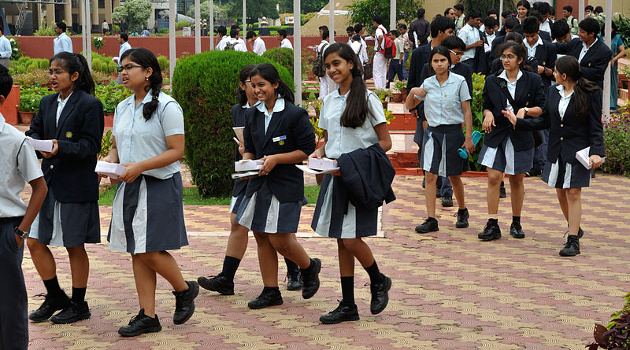I wrote yesterday about the global evidence showing that more money does not improve the lackluster performance of government schools.
Those results are not surprising because we see the same thing in the United States. More money is good for the education bureaucracy, but it doesn’t lead to better student outcomes.
Now let’s focus on the solution to this problem. Simply stated, we need to break up the government education monopoly and unleash market forces.
Previous columns have looked at the success of school choice in Sweden, Chile, and the Netherlands.
Now let’s look at India, another country where private education has experienced amazing growth. I’m actually in that country for some speeches on regulatory reform (specifically, how India can improve its Doing Business score) and I’ve taken advantage of this situation to learn about the amazing developments in education.
We’ll start with some excerpts from a remarkable story in the Hindustan Times.
Between 2010-11 and 2015-16, student enrollment in government schools across 20 Indian states fell by 13 million, while private schools acquired 17.5 million new students, according to a new study that offers insights into India’s public-school education crisis.
Average enrollment in government schools–where teachers are paid, on average, salaries that are four times those in China–declined from 122 to 108 students per school over five years, while it rose from 202 to 208 in private schools… Why are students opting out of India’s government schools, which educate the poorest and most vulnerable students until the age of 14 for free, and migrating to fee-charging private institutions in such large numbers? …private schools offer better value for money and better teaching than government schools.
Yet you won’t be surprised to learn that teachers in the government schools are lavishly compensated.
India’s government teachers earn more than…their counterparts in private schools… Teacher salaries in of teachers in Uttar Pradesh are four to five times India’s per capita gross domestic product (GDP) and more than 15 times the state’s, according to a 2013 analysis by Amartya Sen and Jean Dreze. This is much higher than the salaries paid to teachers in OECD countries and India’s neighbours.
Much of the data in that story was taken from a 2017 study published by a German think tank.
Here are some of the other findings from that report.
Official data show a steep growth of private schooling and a corresponding rapid shrinkage in the size of the government school sector in India, suggesting parental abandonment of government schools. …affordability is an important factor behind the migration towards and growth of private schools. The main reason for the very low fee levels in private schools is their lower teacher salaries, which the data show to be a small fraction of the salaries paid in government schools; this is possible because private schools pay the market-clearing wage…whereas government schools pay bureaucratically determined minimum-wages. Private schools’ substantially lower per-student-cost combined with their students’ modestly higher learning achievement levels, means that they are significantly more cost-effective than government schools.
The study is filled with extensive data.
But rather than quote long passages, here are two charts that caught my eye. First, we see better performance in private schools.
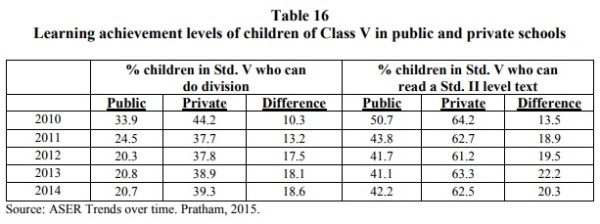
Given these impressive results, the logical response would be for India to scrap government schools and adopt a nationwide system of school choice.
But there’s a very powerful interest group standing in the way. As you can see from this second chart, government teachers are grossly overpaid and they will fight to the death to maintain the status quo.

Now let’s look at some of the findings from a report prepared by Ernst & Young on elementary and secondary education in India.
Once again, we see that parents are voting with their money to send their kids to private schools. Why? Because even though government schools are “free,” parents actually want their kids to get a good education.
…one of the most striking trends in Indian school education is the increase of private sector participation with an estimated 3 lakh private schools with 40% of the total student enrollment. Private enrollment in elementary schools is approximately 35% and over 50% at the secondary level. …private schools deliver higher quality education as gauged by educational outcomes such as performance on board exams and evidence from standardized assessments.
And here are some charts from the report, starting with a look at the share of kids in private schools.
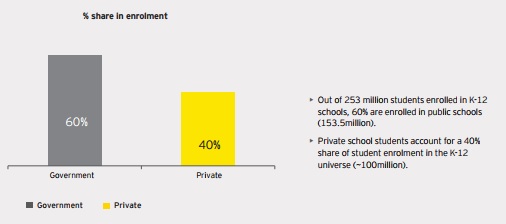
And here’s some additional evidence that private schools generate better student outcomes.
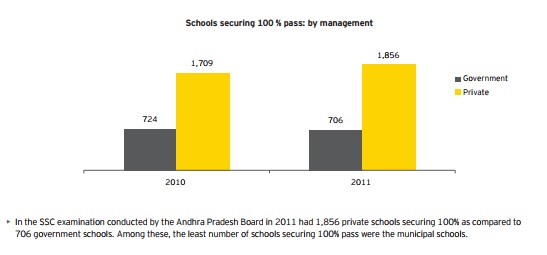
What makes these results especially amazing is that the government has created all sorts of barriers to private schools.
I wrote about this in 2013, but the E&Y report quantifies how politicians and bureaucrats are trying to stifle competition.
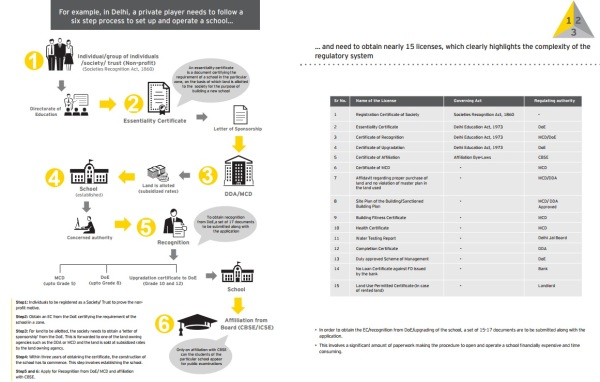
Let’s take a look at some more research.
The Centre for Civil Society also has a must-read report on private education in India.
We’ll start with an excerpt that reinforces the fact that parents are voting with their scarce funds because they want a better future for their children.
Private fee charging schools are loved and loathed in equal measure in India: loved in the sense of being sought after by parents for their children’s education and often reviled by the press/ public/ authorities… The emptying of government schools…is largely the result of an exodus of students from government schools and migration toward private schools… The evidence suggests that most private schools in India can be considered ‘low fee’ in the precise sense that their fee is below the government’s… This evidence discredits the oft-repeated belief that much of private schooling in India is elite and exclusive.
Here’s data showing that the private schools cost less.
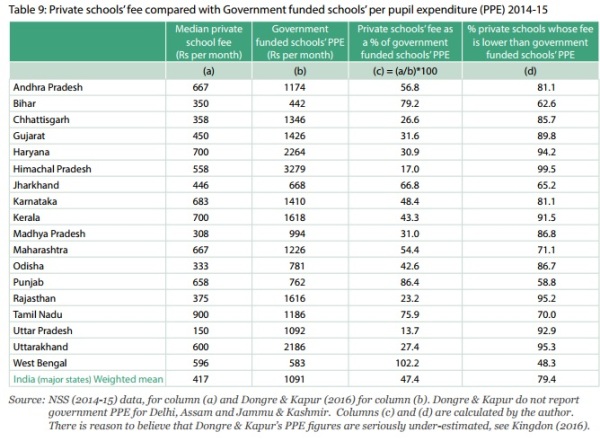
And here’s data showing that private schools deliver better results.
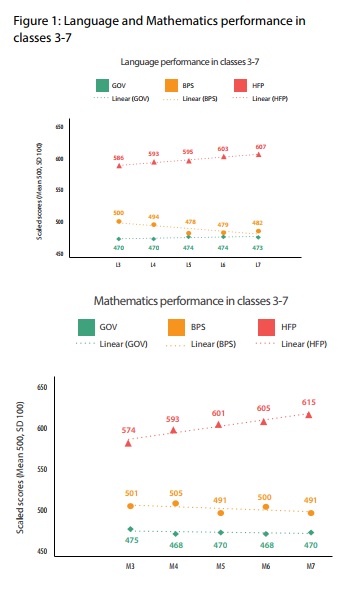
Finally, let’s look at a study by the World Bank that measures inputs and outputs to determine “value for money” (VFM).
PPE in MP government school system is Rs 9384 per annum and in private schools Rs 3700 per annum. Thus, government schools’ PPE is 2.5 times private schools’ PPE. However, the learning units are higher in private schools: 58% of private school students and 28% of government students of class 5 could read a class 2 level text in 2014-15. Thus government schools’ learning output is just about half that in private schools. Putting the output and expenditure items together, we find that the cost per unit of achievement is Rs 338 in government schools and Rs 63 in private schools, implying that private schools are 5.3 times as cost effective as public schools, or that government schools are one fifth as efficient in producing output as private schools. …When home background is strictly controlled for, the raw public-private learning gap greatly falls but is usually not eliminated. … if only 25% of the raw public-private achievement gap of MP is attributed to superior private school quality (e.g., lower teacher absence rates), then private schools are 3.25 more efficient than government schools, rather than 5.3 times. …In summary, there is very low VFM from government expenditure on education, in terms of producing the valued outcome of ‘learning’ among students. The private schooling sector gets significantly higher VFM.
And here are a couple of visuals from the report.
We’ll start with a look at enrollment patterns (a “lakh” = 100,000), further confirming that an ever-growing number of parents would rather pay for a private school than send their kids to a “free” government school.

And here’s some data starkly showing how government teachers are vastly overpaid.

All of which reinforces the “value for money” argument that the private schools get far more bang for the buck.
Let’s conclude with a video. One of the world’s experts on private education in the developing world is James Tooley and his interest was triggered by what he saw in India.
Here he discusses developments in India and other developing nations.
P.S. For those interested in more information about India, I wrote last year about how excessive government is stifling the nation’s economy. Indeed, the country is ranked a lowly #95 in the latest iteration of Economic Freedom of the World. This is very unfortunate because India should be a rich country. Indian-Americans, for instance, are the most successful immigrant group in America.
P.P.S. But it will be hard for Indians in India to achieve similar success since the government keeps imposing bad policies such as “demonetization.”
P.P.P.S. India is also home to the most perverse example of how handouts encourage bad behavior.

